AJKOER
Radically Dubious
    
Posts: 3026
Registered: 7-5-2011
Member Is Offline
Mood: No Mood
|
|
FACILE PHOTOCATALYTIC Zn(OH)2/ZnO PREPARATION AND ASSOCIATED PHOTOLYSIS EXPERIMENTS
I apparently produced a white colloidal, or at least, a fine particle suspension from anodic corrosion of pure zinc metal. Basically, a cloudy
solution is first produced with particles too small to see, but in hours a precipitate does form likely consisting of Zn(OH)2/ZnO. The process
involves a 4 minute microwave treatment of Zinc metal in the presence of graphite rods in household dilute 3% H2O2 with a touch of sea salt (acting as
an electrolyte). The zinc, for educational purposes, was sourced from three US pennies by scraping the outside metal rim, thereby exposing the
underlying zinc metal (see pictures).
EXPLANATION OF UNDERLYING CHEMISTRY
Microwave (MW) technology has apparently gained a niche in the area of inorganic nanostructures (see ‘Microwave-assisted preparation of inorganic
nanostructures in liquid phase’ by Zhu YJ and Chen F at https://www.researchgate.net/publication/262846541_Microwave... ). Also, MW has shown some promise in organizing colloidal particles (see, for
example, ‘Microwave-assisted self-organization of colloidal particles in confining aqueous droplets’ at https://www.ncbi.nlm.nih.gov/pubmed/16910685 ).
With respect to the chemistry, the action of oxygen (or H2O2) is depicted from an electrochemistry perspective as producing Zn(OH)2 (see, for example,
https://corrosion-doctors.org/Electrochemistry-of-Corrosion/... ).
The employment of a microwave in the presence of carbon has in particular been noted in the literature as leading to the formation of powerful
radicals. As such, this home lab preparation is perhaps more correctly viewed as a microwave assisted electrosynthesis (see, for example, this 2007
source, “Generation of hydroxyl radical in aqueous solution by microwave energy using activated carbon as catalyst and its potential in removal of
persistent organic substances” at https://www.researchgate.net/publication/239705822_Generatio... ). One may be able to replace low surface area graphite rods here with other
forms of high area activated carbon (AC) to possibly more rapidly form the ZnO/Zn(OH)2 mix.
As to the mechanics of the reaction system, I believe it is reasonable to assume (as the household H2O2 is acidic for stabilization purposes) the
possible formation of acidic radicals (see ‘Radical-Enhanced Acidity: Why Bicarbonate, Carboxyl, Hydroperoxyl, and Related Radicals Are So
Acidic’ at https://pubs.acs.org/doi/abs/10.1021/acs.jpca.7b08081?src=re... and also https://pubs.acs.org/doi/abs/10.1021/jp984769y?journalCode=j... and my prior comments on SM at http://www.sciencemadness.org/talk/viewthread.php?tid=94166 ).
In particular, relating to the acidic radical HO2•, based on my recent experimenting, employing the action of a microwave (MV) on carbon (as
graphite rods) apparently results in the creation of surface zones containing a deficiency and excess of electrons which can initiate a reaction
chain:
C(surface) + MV --> C(+) + e-
e- + nH2O --> e-(aq)
H2O2 = H+ + HO2-
H+ + e-(aq) = •H
•H + HO2- = •OH + OH-
Note, net of the last 4 reactions:
H2O2 + e-(aq) --> •OH + OH- (described in the literature as the one electron reduction of H2O2)
And further:
H2O2 + •OH --> H2O + HO2•
Followed by the attack of this acidic hydroperoxyl radical. A proposed reaction scheme could be:
Zn --> Zn(+) + e-
e- + nH2O --> e-(aq)
e-(aq) + HO2• --> HO2-
HO2- + H+ (even sourced from water) --> H2O2
which suggests a partial recycling of some of the hydrogen peroxide in the reaction system.
Next, a possible thermal decomposition of some of the zinc hydroxide to produce zinc oxide and water. (see https://chemiday.com/en/reaction/3-1-0-286 ):
Zn(OH)2 ---100 to 250°C--> ZnO + H2O
Also, chemically related discussions in this prior thread employing less user friendly chlorine bleach (or HOCl as derived from weakly acidified
Chlorine bleach) to effect the formation of a metal oxide in a galvanic cell setting at https://www.sciencemadness.org/whisper/viewthread.php?tid=84... .
Interestingly, per Atomistry website (see http://zinc.atomistry.com/zinc_hydroxide.html ) on Zn(OH)2, there is presented some historical paths. Included is an account of Zn/Fe or Zn/Cu
galvanic cell path occurring in basic and acidic conditions on air exposure, to quote:
“It was obtained in rhombic prisms by allowing zinc to remain in contact with iron or copper under aqueous solutions of ammonia or caustic alkalies,
……
Becquerel obtained colourless octahedra by coiling copper strips round strips of zinc and leaving them in a solution of either silicic acid or clay in
caustic alkali.”
In contrast to the current microwave assisted Zn/C/H2O2 path.
Note, there is apparently no simple direct reaction between zinc metal and H2O2 (see https://www.youtube.com/watch?v=ac52QLENEyM ).
-------------------------------
PHOTOLYSIS TESTING OF COLLOIDAL ZnO/Zn(OH)2 MIX
First, with respect to product testing, this source implies that a mix of Zn(OH)2/ZnO actually has photocatalytic properties (see https://pubs.rsc.org/en/content/articlelanding/2015/nj/c5nj0... ). This suggests the possibility of a photolysis test of the produced product mix
to evaluate the photocatalytic effectiveness of the zinc oxide/zinc hydroxide mix, as was produced over some 3 1/2 hours in strong sunlight.
One such embodiment test was based on two solutions created by dissolving half of a Vitamin B Complex pill (see picture), to which was added H2O2 and
NaHCO3. For one solution only, the created ZnO/Zn(OH)2 suspension was also added. The visual results apparently indicate a further acceleration of
the photo decomposition by Vitamin B12 in the presence of the zinc oxide hydroxide mix. It should be noted that Vitamin B12 naturally breakdowns in
sunlight, to quote a source (“Photolysis of vitamin B12” by Leon J. Demerre and Catherine Wilson, extract at https://onlinelibrary.wiley.com/doi/abs/10.1002/jps.30304503... ):
“Sunlight, at a brightness of 8,000 foot‐candles, causes a ten per cent loss for each half hour of exposure.”
with apparently, the •OH radical being catalytically generated by B12 (source: ‘A new trick (hydroxyl radical generation) for an old vitamin
(B12)’, available at https://europepmc.org/articles/pmc3077068 ).
Also, per another source, on yet another B Vitamin, namely B2, also contained in the B-Complex Vitamin pill, apparently produces, on irradiation, some
singlet oxygen (see https://www.sciencedirect.com/topics/agricultural-and-biolog... ):
“Riboflavin or Vitamin B2 was discussed abundantly in this chapter mainly due to its strong photosensitizing characteristics which leads to the
formation of singlet oxygen. Riboflavin is also sensitive towards destruction by the singlet oxygen that it generates because it has a triene
structure with many reactive double bonds (Bradley and Min, 1992). The riboflavin content in milk stored in a gas-tight bottle under light decreased
as the headspace oxygen decreased in the bottle. “
where the action of singlet oxygen with water is a known source of H2O2. Also, per the same source:
“Riboflavin photodegradation can be exacerbated by sodium bicarbonate, which is used to preserve vegetable colors.”
which I account for by the sunlight induced formation also of the carbonate radical, •CO3- . The latter is known as one of the more selective (and
longer half-life) radical species, effective in breaking down various organic compounds.
Next, I decided to continue the photolysis by adding the powerful staining herb turmeric to the prior experiment. Again, I noticed something that I
observed also at the start of the B-Complex run. Namely, that the reduced coloration was also immediately observed in the ZnO/Zn(OH)2 suspension! I
attribute this possibly to the unique electrostatic properties of colloid suspensions. Related supporting articles, include, for example,
“Electrokinetic properties of sepiolite suspensions in different electrolyte media+ at https://www.sciencedirect.com/science/article/pii/S002197970... , where the author states further:
“Charge reversal was observed for divalent cations at 1×10−2M and for trivalent cations at 3×10−4M. As a result, it can be said that
monovalent cations are indifferent ions when di- and trivalent cations are potential-determining ions.”
where in the current context, zinc forms divalent cations, which by charge reversal, may lead to zones of excess electrons, which may further result
in one electron reduction of H2O2 producing •OH and therefrom the carbonate radical:
HCO3- + •OH --> H2O + •CO3-
CONCLUSION
A readily created mix of zinc oxide and hydroxide suspension appears to have photocatalytic ability and may be able to enhance a photolysis system
based on some quick experimental observations.
Note, precise replication of my observed results may be difficult due to the power of the microwave employed, purity of the Zn, the surface area
relative ratio of zinc metal to carbon source and nature of the household dilute H2O2 employed (its pH, presence of particular stabilizers,...).
See attached pictures for more details.
|
|
|
AJKOER
Radically Dubious
    
Posts: 3026
Registered: 7-5-2011
Member Is Offline
Mood: No Mood
|
|
Starting solutions, with the ZnO/Zn(OH)2 suspension on the left.
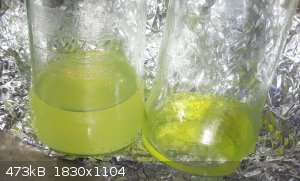
[Edited on 24-8-2019 by AJKOER]
|
|
|
AJKOER
Radically Dubious
    
Posts: 3026
Registered: 7-5-2011
Member Is Offline
Mood: No Mood
|
|
Following photolysis, the Zinc treated solution (now on the right) appears to be more effective in removing the B-Complex Vitamin pill (which is, by
itself, self-decomposing in sunlight).
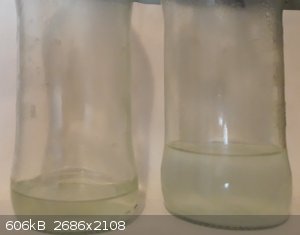
[Edited on 24-8-2019 by AJKOER]
|
|
|
AJKOER
Radically Dubious
    
Posts: 3026
Registered: 7-5-2011
Member Is Offline
Mood: No Mood
|
|
Starting solutions following the addition of equal amounts of the herb tumeric. Note, a large different between the solutions appears before
undergoing sunlight treatment.
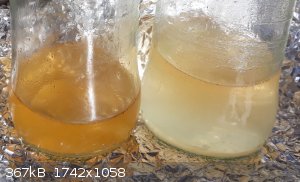
[Edited on 24-8-2019 by AJKOER]
|
|
|
AJKOER
Radically Dubious
    
Posts: 3026
Registered: 7-5-2011
Member Is Offline
Mood: No Mood
|
|
Tumeric treated solutions at the end of the photolysis.
The ZnO/Zn(OH)2 containing solution here also demonstrates better results.
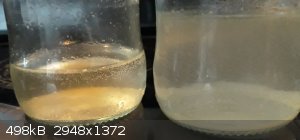
[Edited on 24-8-2019 by AJKOER]
|
|
|
AJKOER
Radically Dubious
    
Posts: 3026
Registered: 7-5-2011
Member Is Offline
Mood: No Mood
|
|
Starting materials.
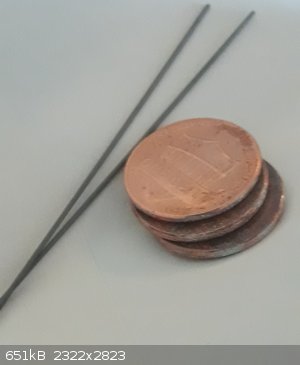
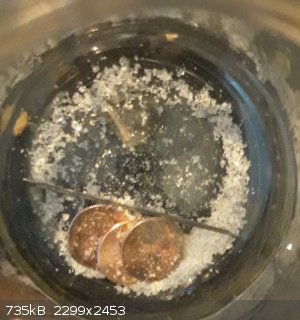
[Edited on 24-8-2019 by AJKOER]
|
|
|
|